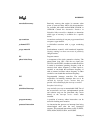
Glossary-3
GLOSSARY
far data Data that can be accessed only with extended instruc-
tions. See also near data.
FET Field-effect transistor.
f Lowercase “f” represents the frequency of the internal
clock. For the 8XC196NP, f is always equal to F
XTAL1
(the input frequency on XTAL1). For the 80C196NU,
which employs a phase-locked loop with clock
multiplier circuitry, f is equal to either F
XTAL1
,
2F
XTAL1
, or 4F
XTAL1
. The multiplier depends on the
clock mode, which is controlled by the PLLEN1 and
PLLEN2 input pins. (Figure 2-4 on page 2-8
illustrates the clock circuitry of the 80C196NU.)
fractional mode A mode of the multiply-accumulate function in which
the multiplier result is shifted left one bit before being
written to the accumulator. This left shift eliminates
the extra sign bit when both operands are signed,
leaving a correctly signed result.
hold latency The time it takes the microcontroller to assert HLDA#
after an external device asserts HOLD#.
input leakage Current leakage from an input pin to power or ground.
integer Any member of the set consisting of the positive and
negative whole numbers and zero.
INTEGER A 16-bit, signed variable with values from –2
15
through +2
15
–1.
internal address The 24-bit address that the microcontroller generates.
See also external address.
interrupt controller The module responsible for handling interrupts that
are to be serviced by interrupt service routines that
you provide. Also called the programmable interrupt
controller (PIC).
interrupt latency The total delay between the time that an interrupt is
generated (not acknowledged) and the time that the
device begins executing the interrupt service routine
or PTS routine.
interrupt service routine A software routine that you provide to service a
standard interrupt. See also PTS routine.
interrupt vector A location in special-purpose memory that holds the
starting address of an interrupt service routine.


















